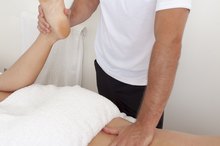Activities to Avoid With Spinal Stenosis
Your nerves travel through your spinal column and then out to various areas of the body. Arthritis and disc problems can cause a narrowing of the spinal column, which can compress your nerves. This narrowing of the spinal column is called spinal stenosis. As the nerves are compressed, you can experience a variety of mild to severe symptoms. Staying active is important to keep the back muscles strong and flexible. However, you must also use caution, as the wrong movements can exacerbate your symptoms. For this reason, you will want to avoid certain activities if you have spinal stenosis.
Long Walks
If you have spinal stenosis, you need to discontinue any activity that exacerbates your symptoms, including pain or sensations of numbness, tingling and weakness. Prolonged walking and standing tend to make the symptoms of spinal stenosis worse, according to the American Academy of Orthopaedic Surgeons. Although walking is helpful for weight loss, overall conditioning and balance, you want to limit yourself to short walks. Break up periods of prolonged standing with sitting or gentle stretching exercises.
- If you have spinal stenosis, you need to discontinue any activity that exacerbates your symptoms, including pain or sensations of numbness, tingling and weakness.
High-Impact Exercises
Physical Therapy Procedures for Pinched Nerves in Lumbar Vertebrae
Learn More
Activities that are high-impact, such as jogging or high-impact aerobics, are generally not recommended if you have spinal stenosis. They place too much force on the spine. Low- or no-impact activities, such as swimming and biking, are better choices. In the initial stages, you may need medication to help control your symptoms so you can begin to exercise. The Arthritis Foundation suggests that you first learn abdominal exercises to help stabilize your spine. This will teach you to engage your muscles and take pressure off your spine during exercise and everyday activities.
- Activities that are high-impact, such as jogging or high-impact aerobics, are generally not recommended if you have spinal stenosis.
- The Arthritis Foundation suggests that you first learn abdominal exercises to help stabilize your spine.
Extension Exercises
When you are first diagnosed with spinal stenosis, it may be helpful to work with a physical therapist who can assess your individual situation and provide guidelines. According to the American College of Rheumatology, you'll want to focus on activities that encourage flexion of your spine. In other words, you want to participate in activities where you lean forward and avoid spinal extension or back bending. Leaning forward tends to create space in the spinal column, which reduces pressure on the nerves. Bending backward can create additional compression and symptoms. Back hyper-extensions and yoga postures, such as the Cobra or Boat poses, are activities that require back extension and should be avoided. Pilates or other exercises that require you to arch your back should also be avoided. Both yoga and Pilates offer other exercises that encourage forward bending or maintaining a straight spine, both of which are more beneficial.
- When you are first diagnosed with spinal stenosis, it may be helpful to work with a physical therapist who can assess your individual situation and provide guidelines.
- Back hyper-extensions and yoga postures, such as the Cobra or Boat poses, are activities that require back extension and should be avoided.
Related Articles
References
- American Academy of Orthopaedic Surgeons: Ask an Orthopaedic Surgeon About Spinal Stenosis
- American College of Rheumatology: Spinal Stenosis
- American College of Rheumatology. Spinal Stenosis. Updated March 2019.
- American Academy of Orthopaedic Surgeons. Lumbar Spinal Stenosis. Updated December 2013.
- Lee SY, Kim T-H, Oh JK, Lee SJ, Park MS. Lumbar Stenosis: A Recent Update by Review of Literature. Asian Spine J. 2015 Oct;9(5):818-28. doi:10.4184/asj.2015.9.5.818
- Akhavan-Sigari R, Rohde V, Alaid A. Cervical Spinal Canal Stenosis and Central Disc Herniation C3/4 in a Man with Primary Complaint of Thigh Pain. J Neurol Surg Rep. 2013 Dec;74(2):101-4. doi:10.1055/s-0033-1349202
- Takenaka S et al. Neurological Manifestations of Thoracic Myelopathy. Arch Orthop Trauma Surg. 2014 Jul;134(7):903-12. doi:10.1007/s00402-014-2000-1
- American College of Rheumatology. Spinal Stenosis. Updated March 2019.
- Issack PS, Cunningham ME, Pumberger M, Hughes AP, Cammisa FP. Degenerative lumbar spinal stenosis: evaluation and management. J Am Acad Orthop Surg. 2012;20(8):527-35. doi:10.5435/JAAOS-20-08-527
Writer Bio
I hold a Master's degree in exercise physiology/health promotion. I am a certified fitness specialist through the American College of Spots Medicine and an IYT certified yoga teacher. I have over 25 years experience teaching classes to both general public and those with chronic illness. The above allows me to write directly to the reader based on personal experiences.









